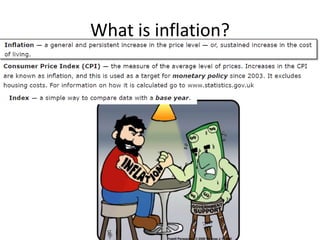
Inflation revision
- 2. How is inflation measured? • The rate of inflation is measured by the annual percentage change in consumer prices. • The British government has set an inflation target of 2% using the consumer price index (CPI) • It is the job of the Bank of England to set interest rates so that aggregate demand is controlled, inflationary pressures are subdued and the inflation target is reached • The Bank is independent of the government with control of interest rates and it is free from political intervention.
- 3. http://www.youtube.com/watch?v=S mOMp8gycMA&safe=active • Inflation is a general and sustained increase in prices. • It is measured by a change in a weighted index of prices such as the CPI
- 4. The CPI • The consumer price index measures price levels • Index numbers are easy to make comparisons with. • You can calculate inflation from this by calculating the percentage change in the index
- 5. The RPI • The retail price index • The RPI is a more reliable measure for negotiating wage increases because it is more inclusive than the CPI as it takes into account housing costs e.g. mortgage interest repayments • However it is not as reliable for international comparisons as it is unique to the UK
- 6. Other problems with CPI • Measure the cost of living for an average household. Pensioners not included • Sampling problems – only 57% of households respond to the survey • The 650 items in the ‘basket’ are changed only once a year, where as peoples tastes and fashions change more frequently
- 7. • For people with atypical spending patterns e.g. vegetarians and non-drivers, the CPI will be unrepresentative. • When the quality of goods changes, the CPI breaks down because it is not comparing like with like.
- 8. Costs and benefits of inflation Sort the cards to identify costs and benefits of inflation Shoe leather costs – consumers must shop around to find the best value goods. The time and effort taken to find the best value involves an opportunity cost
- 9. Causes of inflation Demand pull inflation • Inflation caused by excess demand in the economy Cost push inflation • Inflation caused by increases in the costs of production in the economy
- 10. Causes of Demand pull inflation Where excessive growth in AD results in the economy moving to higher price levels. • This can result from an increase in any component of AD= C+I+G+(X-M) • E.g. an income tax cut will increase consumption resulting in demand pull inflation
- 11. Solutions to demand pull inflation • The bank of England has been given responsibility to target 2.0% CPI inflation. To reduce inflation it will increase interest rates thus reducing AD
- 12. Solutions to demand pull inflation Alternatively, the government could use contractionary fiscal policy to reduce the level of AD, such as: - An increase in tax - A cut in government spending
- 13. Causes of Cost push inflation • Rising input costs e.g. rising price of oil, raw materials or components. • Rising labour costs e.g. shortage of skilled IT workers enabling them to ask for high pay rises • Higher import prices e.g. high inflation in other countries means the goods you import become more expensive (you ‘import inflation’) • Increases in indirect tax e.g. increases in National insurance or an energy tax will increase the costs of producers
- 14. Solutions to cost push inflation • The bank of England is responsible for controlling inflation • The government also pursue policies to shift the AS curve to the right, which will bring the price level down. • However these supply side policies take a very long time to work